

6 Strategies for Writing Essential Questions that Will Inspire Learner – Wabisabi Learning. In any great lesson, an essential question is what drives your learners’ quest for knowledge and discovery.

How do we begin writing essential questions that matter and that inspires our learners? One of the transformations occurring in modern learning is students becoming creators of knowledge. It's why we've defined essential questions as one of the 10 shifts of practice in future-focused learning. In essence, this shift means moving from answering the questions to questioning the answers.
It’s about the quest of pursuing an answer to a question that isn't easily obtainable. The simplest way to define an essential question is to call it an open question. It cannot be answered with a 'yes' or a 'no' or by being labeled true or false. Six Thinking Scaffolds That Can Move Students Toward Deeper Levels of Understanding.
Grotzer and a team (Nancy Oriol, Stephanie Kang, Colby Moore Reilly, and Julie Joyal) looked at the Harvard Medical School MEDscience curriculum, founded by Oriol, that uses technology-mediated, problem-based learning simulations to enrich the experience of high school biology students.
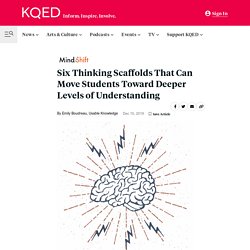
Joyal — executive director for MEDscience — and the team noticed that as their problem-based curriculum progressed, students changed the way they approached problems. Rather than waiting for the teacher to give them answers, they made hypotheses based on existing knowledge, discussed their thoughts with their teams, and took risks — all signs of deeper-level learning. To study this shift in classroom behavior, Joyal, Moore Reilly, and Grotzer used a sample of 21 students from a range of public and private schools in the Boston. “We know that experts pay attention to a very different set of patterns than novices often do.
Taking Students from Novice to Expert. Digital Note Taking Strategies That Deepen Student Thinking. Thinking about thinking helps kids learn. How can we teach critical thinking? Few people doubt the value of developing students’ thinking skills.
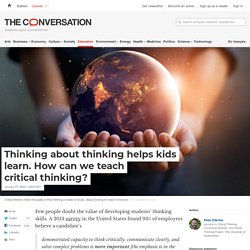
A 2013 survey in the United States found 93% of employers believe a candidate’s demonstrated capacity to think critically, communicate clearly, and solve complex problems is more important [the emphasis is in the original] than [their] undergraduate major. A focus on critical thinking is also common in education. In the Australian Curriculum, critical and creative thinking are known as “general capabilities”; the US has a similar focus through their “common core”. 74 Ways Characters Die in Shakespeare's Plays Shown in a Handy Infographic: From Snakebites to Lack of Sleep. In the graduate department where I once taught freshmen and sophomores the rudiments of college English, it became common practice to include Shakespeare’s Titus Andronicus on many an Intro to Lit syllabus, along with a viewing of Julie Taymor’s flamboyant film adaptation.

The early work is thought to be Shakespeare’s first tragedy, cobbled together from popular Roman histories and Elizabethan revenge plays. And it is a truly bizarre play, swinging wildly in tone from classical tragedy, to satirical dark humor, to comic farce, and back to tragedy again. Critic Harold Bloom called Titus “an exploitative parody” of the very popular revenge tragedies of the time---its murders, maimings, rapes, and mutilations pile up, scene upon scene, and leave characters and readers/audiences reeling in grief and disbelief from the shocking body count.
Part of the fun of teaching Titus is in watching students’ jaws drop as they realize just how bloody-minded the Bard is. Via The Telegraph/Mental Floss. How to Lead Students to Engage in Higher Order Thinking. I teach multigrade, theme-based courses like Spirituality in Literature and The Natural World in Literature to high school sophomores, juniors, and seniors.

And like most English language arts teachers, I’ve taught courses built around the organizing principles of genre (Introduction to Drama), time period and geography (American Literature From 1950), and even assessment instrument (A.P. Literature). No matter what conceptual framework guides the course I’m teaching, though, I begin and anchor it with what I call a thinking inventory. Thinking Inventories and Essential Questions. When Kids Have Structure for Thinking, Better Learning Emerges.
By sixth grade a few students are starting to include some strategies for thinking in their maps, such as “concentrate” or “don’t get caught up in things that aren’t relevant.” Lesson Plan, Meal Plan, and Fitness Plan Templates. Last week Canva announced a handful of new features including a video editor and a desktop application.
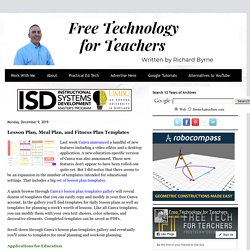
A new education-specific version of Canva was also announced. Those new features don't appear to have been rolled-out quite yet. But I did notice that there seems to be an expansion in the number of templates intended for educational settings. That includes a big set of lesson plan templates. Q&A: Spiral of inquiry. We recently shared the story of a Queensland school that has implemented individual development plans for teachers after a series of professional learning workshops on the spiral of inquiry with Dr Helen Timperley.

Questions Students Can Ask Themselves Before, During, And After Teaching. 75 Questions Students Can Ask Themselves Before, During, And After Teaching by Terry Heick Are there questions students can ask themselves while you’re teaching?
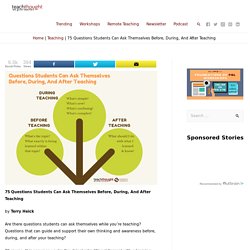
Creating a Student-Run Museum in Your Classroom. The standard school field trip often includes an outing to a museum, but a new resource provides guidance on how to bring a museum into the classroom.
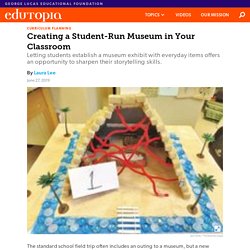
As part of the Mobile Museum Project, the Royal Holloway, University of London, and the Kew Royal Botanic Gardens teamed up to create a Curating a school museum: Teachers’ handbook. The project, which can be used for any age group, turns the premise of a museum on its head: “The primary aim of object-based learning should be to learn from rather than about objects.” Asking questions such as, “What do you want people to learn and why?” And “Who are you hoping to attract and why?” Develop your PLN.
There’s a lot of information out there about PLNs, but sometimes you just want a simple guide to get you started.
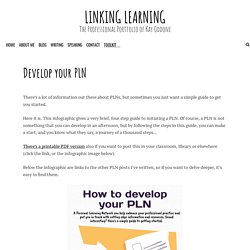
Here it is. This infographic gives a very brief, four step guide to initiating a PLN. Public Media for Northern CA. Chris was a shy, introverted student in my senior-level English class. An Introduction to Note-Taking – The Questing Child. 20 Questions To Guide Inquiry-Based Learning. 20 Questions To Guide Inquiry-Based Learning Recently we took at look at the phases of inquiry-based learning through a framework, and even apps that were conducive to inquiry-based learning on the iPad. During our research for the phases framework, we stumbled across the following breakdown of the inquiry process for learning on 21stcenturyhsie.weebly.com (who offer the references that appear below the graphic).
Most helpfully, it offers 20 questions that can guide student research at any stage, including: What do I want to know about this topic? How do I know I know it? These stages have some overlap with self-directed learning. References Cross, M. (1996). Educational Technology and Mobile Learning: 10 Good Strategies to Foster A Growth Mindset Culture in Your Class. March 20, 2017 In her celebrated book ‘Mindset: The New Psychology of Success’, Stanford university psychologist Carol S. Dweck makes a strong case backed up with scientific evidence for the power of mindset in shaping one’s success or failure in almost every facet of our life.Those with a fixed mindset mentality tend to be limited in their learning scope believing that their inner traits and abilities are biologically determined.
On the other hand, people with a growth mindset embrace change and tend to learn more from life experiences because for them concepts such as skills, abilities and competencies are not fixated and can be developed through a process of error and trial. In today’s post, we are sharing with you this handy infographic we created based on Marcus Guido’s post ’10 Ways Teachers Can Instill a Growth Mindset in Students’. The visual below is also available in PDF format from this link.
Short Film ‘Just Breathe’ Helps Kids Deal with Emotions. We all live, first and foremost, on the inside of our human bodies. But that doesn’t mean that rich inner life we all have doesn’t project itself outward into the everyday world. Quite the opposite: our emotional responses are hard to navigate at any age. Figuring out how and what you are physically feeling is particularly challenging when you’re feeling things like rage, sadness, disgust, and confusion for the first time. Heck, this particular Smart Girl is 29-years-old and I still have a hard time understanding what it all means.